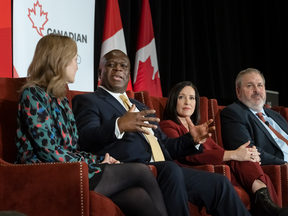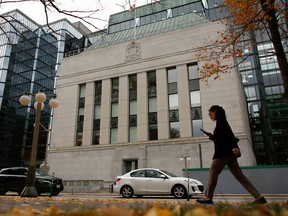Can Alberta really walk off with half the CPP? The Financial Post’s Ian Vandaelle answers your questions
Article content
A new LifeWorks study commissioned by the Alberta government says the province could be entitled to take $334 billion — more than half of assets in the Canada Pension Plan — were it to exit the national plan entirely and start its own fund. The figure has raised eyebrows in pension circles and big questions across the rest of the country: Can Alberta really walk off with half the CPP? And what happens to everyone else if they do? The Financial Post’s Ian Vandaelle breaks down what you need to know about the issue.
Advertisement 2
Article content
Can Alberta actually leave the CPP?
Article content
In short, yes, but we haven’t been down this road before: no province has left the Canada Pension Plan since its inception in 1966. Quebec never joined up with that pact, mind you, so it’s an outlier that has had its own provincial pension plan from the get-go. From there, life gets more complicated: Under the Canada Pension Plan Act, a province would need to give three years notice to the feds that it intends to exit CPP, enact its own legislation within one year of that notice, and prove its own made-at-home pension plan was roughly comparable in terms of providing that safety net. So, not a swift process. And in Alberta’s case, it’s by no means a done deal. The provincial government plans to consult with residents into early next year to gauge their appetite to leave the plan, with the results determining if a referendum is held sometime in 2024.
So they can leave — but why would they want to?
It boils down to a few things, all of which go hand-in-hand: demographics, economics and a lingering sense of Western alienation. On the first point, Alberta skews young — 66.2 per cent of those living in the province are between the ages of 15 and 64, according to the 2021 census, putting it above the national average of 64.8 per cent. That means more contributors to the plan, rather than those collecting benefits, with the province reckoning it can save somewhere in the neighbourhood of $5 billion a year by repatriating its share. The latter two points have been bedfellows for decades: generations of Alberta politicians have griped about the province over-contributing to so-called have-not provinces through equalization payments, mostly due to the province’s resource wealth, and thus there’s always been a simmer of discontent with allowing Ottawa to control the purse strings.
Advertisement 3
Article content
Does the rest of the country get a say?
No. Canada is a democracy, but participating in the CPP was up to the provinces. Quebec, as noted, never joined (but Quebec has a habit of doing things its own way). Alberta can straight up file notice, but that’s where everything gets tricky — they do have to negotiate the amount of cash they’re taking with them with the other provinces, which will surely fight tooth and nail to keep as much in the kitty for their own residents as possible. The third-party LifeWorks report the province commissioned to look into the idea said the province should be entitled to $334 billion of CPP’s assets as of 2027 — more than half of the fund’s projected assets under management — which would be politically unpalatable in the rest of the country.
$334 billion, with a “b”? How does that math check out ?
This is where it gets tricky, and wonkish. First off, according to analysis from the University of Calgary’s Trevor Tombe, the province is probably entitled to something more like 20 per cent of the pot, which would put the withdrawal in the $110-$120 billion range, according to a quick calculation. Still disproportionate to the province’s population, but that does account for the resource wealth generated there. Second, the calculations are difficult because of a change to the CPP Act enacted in the mid-1990s. Before then, CPP was limited in its mandate — it could only invest in bonds, mostly of the provincial variety, with some federal notes mixed in. Since its mandate was expanded it has pushed into everything from stocks to real estate, which ends up bending the math on how things should be divvied up. For example, in Tombe’s analysis, a hypothetical situation in which Ontario, British Columbia and Alberta all withdrew from the CPP — three provinces! — would drain the plan of 128 per cent of its assets. And that doesn’t seem to add up.
Advertisement 4
Article content
-

‘Impossible’ for Alberta to exit with half of CPP assets, official says
-

Stronger loonie pushes CPPIB to narrow investing loss
-

John Graham: CPP is resilient despite choppy markets
So what happens now?
We wait and see. With those consultations underway and a referendum possibly in the offing, there’s no chance Alberta leaves CPP until 2027 at the earliest, which, wouldn’t you know it, coincides with the province’s next scheduled general election. Political seas change, and all that, so who knows what will have happened by then.
• Email: IVandaelle@postmedia.com
Bookmark our website and support our journalism: Don’t miss the business news you need to know — add financialpost.com to your bookmarks and sign up for our newsletters here.
Article content
Can Alberta exit the CPP?
2023-09-22 12:21:41






Comments
Postmedia is committed to maintaining a lively but civil forum for discussion and encourage all readers to share their views on our articles. Comments may take up to an hour for moderation before appearing on the site. We ask you to keep your comments relevant and respectful. We have enabled email notifications—you will now receive an email if you receive a reply to your comment, there is an update to a comment thread you follow or if a user you follow comments. Visit our Community Guidelines for more information and details on how to adjust your email settings.
Join the Conversation